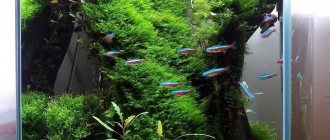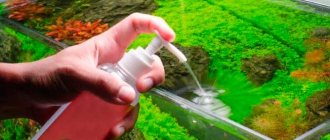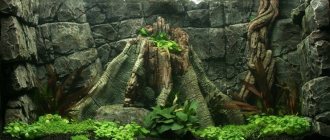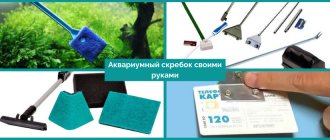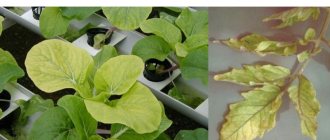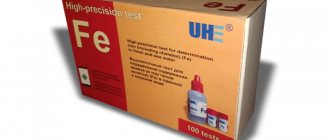Not only the fish in the aquarium need care, but also the algae. For normal growth and reproduction of flora, it is necessary to create a nutrient medium using fertilizers for aquarium plants. Most preparations contain iron and calcium, which ensure normal growth of vegetation. Feeding preparations can be purchased at a pet store or prepared independently.
Aquarium fertilizers will help provide the soil with the nutrients the plants need.
Composition and choice of fertilizing
To ensure that algae do not lose their decorative properties, it is necessary to periodically feed them with preparations that contain additional beneficial substances. It is best to use complex supplements . The composition of the fertilizer includes the following elements:
- iron;
- zinc;
- sodium;
- phosphorus;
- potassium.
To keep the plant in good shape, it is recommended to use preparations that contain nitrogen compounds. They will help prevent stunting and leaf fall. Nitrogen supplements should be applied every day and in small quantities, but we should not forget about the other inhabitants of the aquarium. A high concentration of nitrogen in water can have a negative impact on the condition of fish.
A lack of phosphorus is indicated by dark leaves and brown spots on them. You can use superphosphate or complex fertilizers with phosphorus for plants in the aquarium.
Potassium deficiency appears as brown and yellow spots. In this case, aquarists recommend using potassium phosphate.
When choosing the type and composition of fertilizing, you need to pay attention to the following nuances:
- the amount of algae in the aquarium;
- water temperature;
- carbon dioxide concentration;
- amount of sunlight or artificial light.
When choosing a fertilizer, you should pay attention to the appearance of the plant. It is by this that one can determine what beneficial substances the algae lacks for normal growth and reproduction.
What's on pet store shelves?
Special substrate additives are designed to nourish the soil and the vegetation living in it. As a result, algae develop well, grow and enrich the aquarium liquid with oxygen, which is actively absorbed by waterfowl. Today, such fertilizing preparations are sold freely or prepared by owners of home ponds according to special recipes.
For a comfortable stay of plants in the aquarium space, you need:
- microelement substances (boron, iron, zinc, copper substances, molybdenum);
- macronutrient components (phosphorus, potassium, nitrogen compounds);
- magnesium, bicarbonate and calcium salts.
Today, on the shelves of specialized supermarkets there is a wide range of complex nutritional substances in solid form or in liquid solutions.
Most often purchased:
- AQUAYER Ermolaeva iron plus – with the iron content that the aquarium requires;
- BIO VERT NANO – fertilizer containing a complex of feeding elements;
- Tetra is a dissolving complex based on phosphorus, potassium and nitrogen.
Most often, such substances are produced by the manufacturer in ampoules. Before introducing them into the aquarium, you will need to carefully study the instructions for using the drug that fertilizes the aquarium space, because they are designed for a certain amount of water. When purchasing liquid substances, you should also strictly follow the attached instructions, which describe the amount of liquid for a specific aquarium volume.
Solid substances, such as tablets, can be used for aquarium feeding. Before using this drug for the first time, you should carefully read the instructions so as not to harm the pets or vegetation living in the aquarium, however, most often such drugs are prepared by aquarists themselves.
Main varieties
Feeding preparations differ not only in composition, but also in type. All of them have their own indications for use. The following groups of fertilizers can be distinguished:
- macro- and microfertilizers;
- liquid;
- hard;
- clay;
- vermicompost;
- peat;
- sidex.
The choice of a specific form of the drug depends on the preferences of the aquarist and plants. Liquid ones are more convenient to use, although solid ones help create a nutrient medium for a long period.
Liquid preparations
When choosing a specific preparation for feeding, it is important to know what exactly the plant lacks. There are both complex additives and micro- and macrofertilizers. They contain only one active substance. Most often they come in liquid form.
Liquid fertilizers for aquarium plants are among the most popular. They are great for those algae that absorb all the beneficial substances from their leaves. The popularity of such tools is explained by their ease of use.
You can find many different medications at the pet store. For example, Tetra brand products promote the formation of chlorophyll and contain potassium, iron and manganese. The Aquabalance series of preparations are universal preparations that are suitable for most algae.
Solids
Solid fertilizers are available in the form of granules, tablets and nutrient substrate. Fertilizer tablets for aquarium plants are most often placed under the root system. Unlike liquid preparations, solid supplements take effect gradually. The main advantage of such products is their long-lasting effect.
The most popular form is tablet form. For example, the Tetra company produces tablets that contain a whole range of nutrients.
A nutrient substrate used as a top dressing helps saturate the soil with all the necessary microorganisms. It accelerates the growth and proliferation of algae.
To nourish plants, you can also use special clay, which is rich in vitamins and microelements. Its pieces are placed under the roots or simply rolled into balls and buried directly in the aquarium soil. The peculiarity of this clay is that it not only nourishes plants, but is also a good adsorbent, that is, it absorbs all harmful substances from the water.
Solid fertilizers are suitable for root feeding of plants.
Vermicompost is used for spot feeding. It is often combined with peat. When applying, vermicompost granules can be mixed with clay and water. Organic substances from such fertilizing gradually penetrate into the substrate, so the created nutrient medium is preserved for quite a long time.
Peat is used not only to saturate the soil with useful substances, but also to regulate the acidity level of water. This additive softens water and helps fight fungus and germs. Peat for aquariums is available in several forms: granules, emulsion or solution. The disadvantage of this feeding is that it tends to color the water yellow.
Sidex is used to combat overgrown bushes. The effect of this drug is that it affects algae, and some of them die. At the same time, the drug does not harm fish or other microorganisms in any way.
Rules for using homemade fertilizers for an aquarium
The wrong approach to using aquarium fertilizers can have a detrimental effect. This applies to both professional compositions and self-mixes. To avoid negative effects, you should adhere to the following rules:
- start using nutrient solutions with doses reduced by a quarter of the recommended;
- after adding the solution, monitor the condition of the water, plants and other aquarium inhabitants, gradually adjusting the dose;
- apply microfertilizers in the morning, half an hour before turning on the lights;
- do not use microfertilizers at the start-up stage of the aquarium until the nitrogen cycle has been established and the grass has taken root and started to grow;
- To avoid bacterial and algae outbreaks, never exceed the recommended dosage.
It is also worth keeping in mind that the effect of applying microfertilizers is not immediately visible. You can understand whether the composition used is suitable for plants about a month after you start using it.
Application schemes
Aquarium plants must be fertilized according to a special scheme. Often, branded packaging indicates how and when to use the drug. It is recommended for the novice aquarist to use scheme E. The peculiarity of this fertilization scheme is that it helps to achieve intensive growth and bright greenery. It is more suitable for those aquariums where vegetation predominates.
There is another scheme for introducing nutrients - PPS. It is suitable for those aquariums where algae and fish are in almost equal quantities. The advantage of this fertilization method is that it makes it possible to stop the development of algae when aquarists deem it necessary.
About lighting
Under light optimal for photosynthesis, many fish lose their appearance. Amazonian characinids should be kept generally in semi-darkness, otherwise they look like skeletons in translucent shells. The effect of low light is true even for cichlids that are naturally brightly colored. For example, anyone who tried to hold Ramirez's apistograms in ordinary light will hardly believe that on the left in Fig. this is who she is. And normal lighting turns the diamond lamprologus (on the right) into a gray, but very aggressive log.
Aquarium cichlid fish in low light
Note: the red one with green behind the lamprologus is gyrinoheilus, nicknamed Vacuum Cleaner. I gnawed natural, naturally stained driftwood down to pencil sticks. If her Vietnamese ate...
Goldfish faded in bright light
Strong light can also directly affect the color of fish; especially purebred gold ones. For example, a chic black-velvet telescope simply fades under the light of phytolamps, and a five-color shubunkin fades to a two-color mongrel, see fig. on right.
Hence the golden rule for dimly lit aquariums: do not fertilize! Choose shade-tolerant plants, make island lighting and generally use anything except fertilizer! Plants simply will not assimilate them, and what they do not assimilate will harm the fish.
DIY cooking
Fertilizers for feeding aquarium plants can be purchased ready-made at a pet store or prepared at home yourself. To prepare the fertilizer yourself, you should have basic knowledge of chemistry. You will also need the following tools:
- precision scales;
- thermometer;
- latex gloves;
- stirring sticks;
- flasks;
- beaker;
- reagents.
Scales must be as accurate as possible. To prepare microfertilizers for an aquarium yourself, you will need a bottle with a volume of at least 1 liter. The following reagents will also be required:
- copper;
- boric acid;
- manganese sulfate;
- ammonium molybdate;
- zinc.
The water for cooking should be prepared in advance - heated to 35-40 degrees, in total you will need about 0.5 liters. All components must be mixed in the following order: ammonium molybdate, copper, zinc, manganese and boric acid. When all the reagents have dissolved, another 0.5 liters of water must be added to the container. It must be distilled and heated.
Fertilizers for aquarium plants can be purchased or prepared independently.
This fertilizer must be added to the water every day in the following proportion: 0.5 ml per 100 liters of water - this is the minimum dosage. The maximum allowable amount of the additive is 1 ml per 100 liters of liquid. The optimal dosage should be selected experimentally.
Preparing microelement fertilizer will take less time. In this case, it will be enough to mix 3 separate solutions. The most commonly used solutions for preparation are:
- nitrate;
- potassium;
- phosphate.
A phosphate solution can be obtained by mixing 72 g of potassium phosphate and 1 liter of water. It is recommended to add it to the aquarium once at the rate of 1 ml per 100 liters.
To prepare a nitrate solution you will need 60 g of potassium nitrate. The dry base must be dissolved in 1 liter of liquid. The nitrate solution is added in the same volume as the phosphate solution.
To make a complex fertilizer with your own hands, you will need a fairly large amount of chemical reagents. In particular, the following components are required:
- boiled distilled water;
- ferrous sulfate;
- magnesium sulfate;
- copper sulfate;
- lemon acid;
- zinc sulfate.
All these ingredients must be added sequentially. The prepared base for fertilizer should sit for an hour. Then boric and sulfuric acid, vitamin B12, potassium sulfate and cytovit must be added to the solution.
Fertilizers must be applied strictly according to the instructions, as an excess of them can lead to the death of plants.
During work, you must adhere to all safety rules. Sulfuric acid is especially dangerous. After all the components are mixed, you need to add another 300 ml of water. It is recommended to apply such a complex fertilizer at the rate of 1 ml per 50 liters of liquid.
You can purchase all the necessary ingredients in a specialized store, but you should keep in mind that in small towns there are no such outlets, so some components need to be looked for in a pharmacy, and some can be bought in stores for gardeners and gardeners.
Experienced aquarists prefer preparing fertilizers for aquarium plants with their own hands. The advantage of such solutions is their long shelf life and maximum efficiency, since all the components are selected by the aquarist himself. The optimal dose is calculated experimentally. Depending on the lighting of the aquarium, the amount of water and the condition of the algae, you can change the dosage.
All aquarium plants need feeding with vitamins and minerals. There are many ready-made preparations that can be purchased at a garden store. If desired, you can also add folk remedies - clay or peat, or prepare fertilizer based on chemical reagents yourself.
Where to buy reagents
Beginning aquarists who have learned about the need to add fertilizers to the aquarium often have a question about where they can get the components specified in the solution recipes. You can buy chemical reagents in the following places:
- At pharmacies.
- In home and garden stores.
- In places specializing in the sale of chemicals.
Experienced owners of large tanks with dense vegetation recommend using homemade fertilizers, as it is more profitable. Homemade nutrient mixtures can be stored for a long time in a secluded place, inaccessible to direct sunlight, and alternate the order of adding solutions to the aquarium. In addition, the dosage can be changed taking into account factors such as lighting in the tank, capacity of the container and the state of the aquatic flora.
Green inhabitants of artificial reservoirs take care of fish and shellfish, providing pets with shelter in their leaves and producing oxygen, so every aquarist knows how important it is to maintain the health of underwater vegetation. To achieve this goal, aquarium owners use liquid or solid fertilizers, which are prepared at home, following instructions and recipes.
